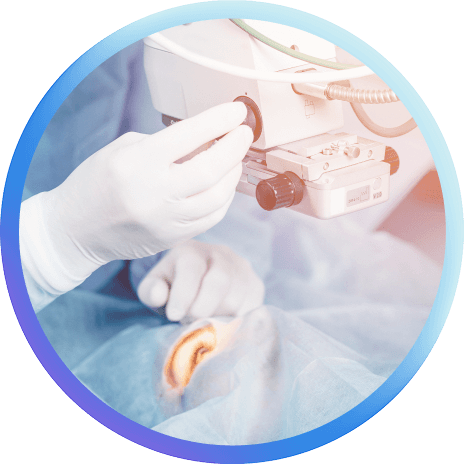Cataracts
Cataract Surgeons in Western Illinois and Eastern Iowa

If you are experiencing blurry vision, faded colors, or difficulty seeing at night, you may suffer from cataracts. At Eye Surgeons Associates, we understand how cataracts can impact your daily life. That’s why our team of skilled ophthalmologists is dedicated to providing expert care to the Quad Cities community.
Do you have trouble seeing clearly? Are colors looking dull? Is it hard to see at night? You might have cataracts. At Eye Surgeons Associates, we know how this can make daily tasks hard. Our team of skilled surgeons has helped thousands of patients in the Quad Cities see better. Our experienced ophthalmologists use the best tools to care for the eyes of our patients.
What is a Cataract?
A cataract is a slow, progressive clouding of the eye’s natural lens. It interferes with light passing through the eye to the retina. Cataracts are caused by a change in the proteins of the eye, which causes clouding or discoloration of the lens.
People with progressed cataracts often describe the sensation as looking through a piece of wax paper. A cataract may make the light seem too bright, causing glare. For example, oncoming headlights may cause an uncomfortable glare, making driving at night more difficult. Colors may not appear as vibrant. Most cataracts, however, develop so slowly that people usually don’t realize their color vision has deteriorated.

A cataract is a slow, progressive clouding of the eye’s natural lens. It interferes with light passing through the eye to the retina. Cataracts are caused by a change in the proteins of the eye, which causes clouding or discoloration of the lens.
Is Your Cataract Ready to be Removed?
A Cataract Explained in 20 Seconds
If your vision affects your daily life and your ability to enjoy the world around you, schedule an appointment today.
Causes of Cataracts
- Getting older – age is a significant cause of developing cataracts
- Congenital disability, like abnormal conditions in the eyes of unborn babies
- Environmental factors such as disease, toxic chemicals, medications
- Accidents or injuries
- Exposure to ultraviolet light
- Cigarette smoking
Symptoms
- Need more light to read
- Frustration from bright lights
- Night driving problems
- Increased eyestrain
- Double vision
- Cloudy, fuzzy, and blurry vision
- The colors seem faded or yellowish
- Frequent changes in eyeglass prescription
Cataract Consent Video
English
Español
Cataract Surgery
Eye Surgeons Associates has proudly restored vision to thousands of Quad City area residents for over four decades. We introduced the most advanced techniques to the region, such as outpatient surgery, topical (no shot) anesthesia, suture-free incisions, and phacoemulsification, with world-class results.
ESA, in partnership with Spring Park Surgery Center and Mercy One, was the first to acquire a femtosecond laser and introduce laser refractive cataract surgery to the Quad Cities region.
Today, patients can choose to have traditional cataract surgery or laser-assisted cataract surgery based on their eye health, vision goals, and input from their surgeon.

Traditional Cataract Surgery
An outpatient procedure, traditional cataract surgery uses handheld instruments. A blade cuts the self-sealing incision in the clear cornea, and manual forceps grasp and fashion a circular opening in the bag of the cataract. An instrument working like a microscopic jackhammer breaks up the cataract with sound waves, allowing the cloudy lens material to be vacuumed out of the eye. Finally, the surgeon implants a monofocal (one focus) intraocular lens (IOL) into the cleaned bag of the now-removed cataractous lens.
The implanted lens is intended to last a lifetime. Patients typically have both eyes corrected for clear distance vision and continue to rely on glasses (readers, bifocals, trifocals, or progressive lenses) for optimal distance, intermediate, and near vision.
Your medical insurance and/or Medicare covers traditional cataract surgery and standard monofocal (one focus) IOLs to restore your best vision in glasses, which will be required for most if not all, daily tasks.
Traditional Cataract Surgery
Laser Assisted Cataract Surgery
Laser Cataract Surgery with Advanced Technology Treatment
Laser surgery can be done with any Advanced Technology IOL or refractive treatment to reduce or eliminate the need for glasses. The laser allows your surgeon to plan and perform a completely customized procedure for each of your eyes. The laser improves precision and reproducibility in creating blade-free incisions and other steps of cataract removal. The laser’s accuracy is approximately ten times greater than manual techniques.1,2 After creating the corneal incisions, the laser creates a fast, precise circular opening in the cataract bag.
The laser then softens and divides the cataract, so the surgeon can remove the cloudy material. Laser technology makes the breakup and cataract removal safer, easier, and gentler for the patient’s eye.3 The laser reduces the amount of ultrasound energy (microscopic jackhammer sound wave energy) used to break up the cataract by 43%, reducing the risk of cell loss.3 Laser treatment causes little to no discomfort for patients.
LenSx Laser
What To Do If Your Cataracts Feel Like They’re Coming Back
1. Friedman, NJ, et al., “Femtosecond Laser Capsulotomy,” Journal of Cataract & Refractive Surgery, 2011 July; 37(7): 1189-1198
2. Palanker, D., et al.., “Femtosecond Laser-Assisted Cataract Surgery with Integrated Optical Coherence Tomography,” Science Translational Medicine, Vol 2 Issues 58: 1-9 (2010)
3. Nagy Z. Initial clinical evaluation of an intraocular femtosecond laser in cataract surgery. Refract Surg. 2009 Dec, 25 (12): 1053-60.
LenSx® Laser – Important PATIENT Product Information
CAUTION: The LenSx® Laser is legally restricted to sale and use by physicians or on their orders.
DESCRIPTION: The LenSx® Laser is used in patients undergoing cataract surgery. It is used as a tool to break up a cataract and create incisions in the cornea. The LenSx Laser can also be used to create corneal flaps in LASIK surgery. The LenSx Laser uses Patient interface accessories to hold the eye steady during a procedure.
WARNINGS / PRECAUTIONS: The LenSx Laser Patient Interface and the LenSx SoftFit Patient Interface hold an eye by applying light suction. Some bleeding and foreign body sensations may occur. As with any cataract surgery, there are risks involved. These risks may include but are not limited to infection, pain, corneal abrasion, and capsular tear. Surgery with the LenSx Laser is not for everyone. Conditions such as corneal opacity, glaucoma, a poorly dilating pupil, and previous corneal surgery may preclude using the LenSx Laser. Your doctor can determine if the LenSx Laser is right for you.
The accuracy of these steps, including the precise circular opening of the cataract bag, promotes optimal positioning of the Advanced Technology IOLs to reduce or eliminate glasses. These lenses depend upon a level of precision and customization that traditional manual surgery struggles to provide.
The additional diagnostic and laser surgical services and Advanced Technology IOLs are expenses beyond traditional cataract surgery and are not covered by insurance. Eye Surgeons Associates also offers monthly payment options for long- and short-term financing through CareCredit.
If you are employed and have participated in an employer-sponsored “cafeteria” or “flex” medical benefit plan, the IRS has determined that vision correction is a qualified deductible medical expense. Advanced Technology Lenses and associated services qualify for payment.
Please check with your insurance company or employer’s human resources department.
Our Pledge To You
Through skill, knowledge, and understanding of your needs, our team of physicians, technicians, and staff strives to provide the most efficient and caring rehabilitation of vision after cataracts. If you have any questions about the surgery, please contact your doctor or their staff.

Advanced Technology Options to Reduce or Eliminate Your Need for Glasses
Many Advanced Technology Options are available to reduce or eliminate your need for glasses by remedying your astigmatism, nearsightedness, farsightedness, and presbyopia – all reasons patients need glasses. Eye Surgeons Associates offers thorough eye examinations for adults and children, addressing refractive errors, myopia management, and age-related vision changes. With the only pediatric ophthalmologist in the QCA, ensuring children receive eye screenings and treatments to promote good vision is a priority.
See your options at cataracthelp.com
Choosing A Lens Implant for Cataract Surgery
Monovision Explained
Blended Vision
With Blended Vision, the surgeon corrects one eye for distance vision and aims for intermediate focus (computer screen, sheet music, shopping or kitchen counter, etc) for the second eye. Many contact lens wearers and former LASIK surgery patients know this concept. It trades away some distance and depth perception to provide the near help. In most circumstances, the brain merges the two images without the patients’ awareness, so many daily activities can be done without glasses for those without astigmatism.
Patients occasionally wear prescription glasses to improve their sharpest vision at any distance, but especially for reading the fine print. Additional testing, which is not covered by insurance or Medicare, is required to determine whether you are a reasonable candidate for Blended Vision.
Astigmatism
If you have significant cataracts and astigmatism and desire to see clearly at ANY distance without glasses, you require Advanced Technology Refractive Vision Correction. In astigmatism, the front of the eye is not shaped perfectly round but is more irregular, like the back of a spoon. Unless corrected, the vision will remain distorted or blurred.
Our surgeons select the most appropriate astigmatism correction technique for your needs (laser astigmatism correction, Toric IOL, or some combination of the two). Patients with Advanced Technology Astigmatism Correction typically enjoy excellent vision at one distance but may still need glasses for other distances. However, once they decide upon advanced technology astigmatism correction, a Blended Vision strategy may be chosen.
Learn about specific lenses at cataracthelp.com
Multifocal IOLs
As we age, we lose our ability to change focus from distance to near, an automatic process called accommodation. This universal aging process is called presbyopia. Multifocal Advanced Technology Vision Correction lenses can correct both distance driving AND near vision for reading in each eye, resulting in the greatest spectacle independence with the best depth perception for appropriate candidates. The refractive cataract laser may be employed with these presbyopia Advanced Technology lenses to address corneal astigmatism and to enhance IOL placement within the capsular bag.
Learn about specific lenses at cataracthelp.com
Light Adjustable Lens (LAL) by RxSight™
Eye Surgeons Associates is the first practice in Iowa to offer the Light Adjustable Lens (LAL) by RxSight™ to cataract patients. This lens allows patients to customize their visual outcome. The Light Adjustable Lens delivers superior vision outcomes that non-adjustable IOLs cannot match. In a study of 600 subjects, those who received the Light Adjustable Lens followed by adjustments were twice as likely to achieve 20/20 vision at 6 months without glasses as those who received a standard monofocal IOL.1 This single vision, or monofocal IOL, can also be used for blended vision.
With traditional cataract lens replacement surgery, the doctor chooses the lens prescription before surgery, and adjustments to correct vision after surgery are made with glasses or contacts.
With the new LAL, the doctor can adjust vision using UV light after surgery. The LAL allows patients to test drive different vision correction strengths after surgery and choose the best option.
A few weeks after surgery, when the eye is healed, patients return to the doctor for any adjustments. The doctor uses UV light to change the shape of the implanted lens, which changes the vision correction. The procedure takes about 90 seconds; patients typically require two to four treatments. Most patients who choose the LAL can see very well and reduce their need for glasses.
After surgery, patients must wear special UV-blocking glasses at all times, except when sleeping, until the doctor has completed the treatments. Total wear time is typically four to six weeks after surgery.
This exciting new lens is FDA-approved and has already been used successfully by thousands of patients worldwide. Ask your doctor if you are a good candidate and to explain the possible risks and benefits related to the RxSight Light Adjustable Lens.
Learn about specific lenses at cataracthelp.com
RxSight Light Adjustable Lens
FAQ with Dr. Fenzl on the LAL
1 US Food and Drug Administration. Summary of Safety and Effectiveness (SSED) of Light Adjustable Lens and Light Delivery Device system.
IMPORTANT SAFETY INFORMATION
Approved use: The Light Adjustable Lens and Light Delivery Device (LDD) system is approved for patients who have a cataract and need surgery for it, have corneal astigmatism (at least 0.75 diopters) before surgery, and do not have preexisting macular disease.
Who should not receive this treatment? The Light Adjustable Lens and LDD system should not be used if you are taking medications that may increase your sensitivity to ultraviolet (UV) light; if you are taking a medication that is considered harmful to your retina; if you have a history of herpes eye infection or uncontrollable eye movements (nystagmus); or if you are unable to comply with your doctor’s schedule of LDD light treatments and instructions for wearing special UV-protective glasses for several weeks following cataract surgery.
What warnings should I be aware of? Preexisting macular disease and certain eye conditions may increase the risk of complications. Your doctor will determine if you are a good candidate for the Light Adjustable Lens. If you have any complications during your cataract surgery before the Light Adjustable Lens is implanted, you may need to have another intraocular lens (IOL) implanted instead of the Light Adjustable Lens.
What precautions should I be aware of? The safety and effectiveness of the Light Adjustable Lens and LDD have not been established in patients with certain preexisting eye conditions or in patients who experience certain complications during cataract surgery. You should discuss these issues with your doctor. Following surgery, you must wear the special UV-protective glasses during all waking hours for about 4 to 5 weeks and comply with your doctor’s schedule of LDD light treatments. Failure to wear the UV-protective glasses can result in an unpredicted vision change or loss of vision quality after exposure to UV light, such as from sunlight. This may require a second surgery to remove the Light Adjustable Lens from your eye and replace it with another IOL.
What are the potential risks? As with any surgical procedure, there are risks associated with cataract surgery and IOL implantation. Please discuss these risks with your doctor. Potential risks associated with LDD light treatments include mild alterations to color perceptions; temporary scratchiness, irritation, or dryness to the front part of your eye; and activation of a previously undiagnosed herpes eye infection. Longer lasting and serious adverse events related to the UV light exposure are possible, but rare. There is a small chance that your vision could be made worse or that you may require additional surgery as a result of a complication.
Caution: Federal law restricts this device to sale by or on the order of a physician.
Advanced Technology Options Include:
Further examination, additional measurements, and special testing all precede our doctors’ final discussion and planning if you select Blended Vision or Advanced Technology Options. The additional diagnostic and surgical services, as well as the Advanced Technology IOLs, are expenses beyond traditional cataract surgical fees. Though not covered by insurance, ESA offers payment plans to make these options affordable. Whether you select traditional, Blended Vision, or Advanced Technology Refractive Vision Correction, your ESA team will deliver our best efforts to help you achieve your vision goals.
Advanced Technology Payment Options
Medicare and/or insurance typically cover the basic service of cataract surgery with your usual co-pays and deductibles. The cost of upgrading to Advanced Technology Treatment with Refractive Vision Correction is not covered by Medicare or private insurance, and you will need to pay for the additional services. Eye Surgeons Associates offers monthly payment options for long- and short-term financing through CareCredit.
If you are employed and have participated in an employer-sponsored “cafeteria” or “flex” medical benefit plan, the IRS has determined that vision correction is a qualified deductible medical expense. Advanced Technology Lenses and associated services qualify for payment.
Please check with your insurance company or your employer’s human resources department before making your appointment.
CareCredit* is the credit card exclusively designed for healthcare services. Minimum purchase amounts vary for qualifying purchases per CareCredit plan. Not all promotional financing options are available, see ESA staff for details.
*Subject to credit approval. Minimum monthly payments required. Visit www.carecredit.com for details.
